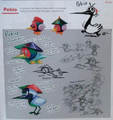Pokio: Difference between revisions
MatiasNTRM (talk | contribs) mNo edit summary |
No edit summary |
||
| Line 6: | Line 6: | ||
'''Pokios''' are pheasant-like enemies found in [[Seaside Kingdom]], [[Bowser's Kingdom]], and [[Darker Side]] in ''[[Super Mario Odyssey]]''. They wander around and poke [[Mario]] with their beaks when he approaches them. According to the [[Bonneter biologist]], their beaks are normally short due to being in an extremely folded state, but shoot outwards when they are opened. To [[capture]] them, the player must first knock off the samurai helmet that they wear. Once captured, Mario can poke enemies with his beak. If Mario pokes at a wall, he can cling onto it and fling himself any desired direction; this is useful for climbing up walls. Additionally, with his beak, Mario can flick incoming bombs the opposite direction, which can be used to chuck bombs at destructible blocks. Spinning fast enough makes Pokio perform a spin attack, which, if used while poking a wall, causes the Pokio to jump about the height of a [[Somersault|Backwards Somersault]]. | '''Pokios''' are pheasant-like enemies found in [[Seaside Kingdom]], [[Bowser's Kingdom]], and [[Darker Side]] in ''[[Super Mario Odyssey]]''. They wander around and poke [[Mario]] with their beaks when he approaches them. According to the [[Bonneter biologist]], their beaks are normally short due to being in an extremely folded state, but shoot outwards when they are opened. To [[capture]] them, the player must first knock off the samurai helmet that they wear. Once captured, Mario can poke enemies with his beak. If Mario pokes at a wall, he can cling onto it and fling himself any desired direction; this is useful for climbing up walls. Additionally, with his beak, Mario can flick incoming bombs the opposite direction, which can be used to chuck bombs at destructible blocks. Spinning fast enough makes Pokio perform a spin attack, which, if used while poking a wall, causes the Pokio to jump about the height of a [[Somersault|Backwards Somersault]]. | ||
These two skills are necessary in the first boss fight against [[RoboBrood]], as Mario (under Pokio form) must flick bombs at the RoboBrood's legs, topple it, and then climb on top of it with his beak to poke the [[Broodals]] in their domes or [[Ground Pound|ground-pounding]] them as Mario. | These two skills are necessary in the first boss fight against [[RoboBrood]], as Mario (under Pokio form) must flick bombs at the RoboBrood's legs, topple it, and then climb on top of it with his beak to poke the [[Broodals]] in their domes or [[Ground Pound|ground-pounding]] them as Mario, while the Pokio emits canary sounds. | ||
The Pokio's name is a play on the words "poke" and {{wp|Pinocchio}}, a character whose nose grew whenever he lied. Their design is based on the Japanese {{wp|green pheasant}}, though the {{wp|red-crowned crane}} was considered.<ref>Roberts, R.; Blenk, J. (2017). ''[[The Art of Super Mario Odyssey]]''. [[Dark Horse Comics]]. p. 273.</ref> The [[Prima Games|Prima]] guide mistakenly classifies them as {{wp|woodpecker}}s. | The Pokio's name is a play on the words "poke" and {{wp|Pinocchio}}, a character whose nose grew whenever he lied. Their design is based on the Japanese {{wp|green pheasant}}, though the {{wp|red-crowned crane}} was considered.<ref>Roberts, R.; Blenk, J. (2017). ''[[The Art of Super Mario Odyssey]]''. [[Dark Horse Comics]]. p. 273.</ref> The [[Prima Games|Prima]] guide mistakenly classifies them as {{wp|woodpecker}}s. | ||
Revision as of 09:36, December 26, 2021
Template:Species-infoboxTemplate:Quote2 Pokios are pheasant-like enemies found in Seaside Kingdom, Bowser's Kingdom, and Darker Side in Super Mario Odyssey. They wander around and poke Mario with their beaks when he approaches them. According to the Bonneter biologist, their beaks are normally short due to being in an extremely folded state, but shoot outwards when they are opened. To capture them, the player must first knock off the samurai helmet that they wear. Once captured, Mario can poke enemies with his beak. If Mario pokes at a wall, he can cling onto it and fling himself any desired direction; this is useful for climbing up walls. Additionally, with his beak, Mario can flick incoming bombs the opposite direction, which can be used to chuck bombs at destructible blocks. Spinning fast enough makes Pokio perform a spin attack, which, if used while poking a wall, causes the Pokio to jump about the height of a Backwards Somersault.
These two skills are necessary in the first boss fight against RoboBrood, as Mario (under Pokio form) must flick bombs at the RoboBrood's legs, topple it, and then climb on top of it with his beak to poke the Broodals in their domes or ground-pounding them as Mario, while the Pokio emits canary sounds.
The Pokio's name is a play on the words "poke" and Pinocchio, a character whose nose grew whenever he lied. Their design is based on the Japanese green pheasant, though the red-crowned crane was considered.[1] The Prima guide mistakenly classifies them as woodpeckers.
Gallery
Names in other languages
| Language | Name | Meaning | Notes |
|---|---|---|---|
| Japanese | ツックン[?] Tsukkun |
Contration of「突く」(tsuku, to poke) and honorific「くん」(-kun) | |
| Chinese (simplified) | 啄啄儿[?] Zhuó zhuó er |
From 啄 (zhuó, to peck) | |
| Chinese (traditional) | 拮拮[?] Jié jié |
From the Japanese name | |
| Dutch | Pokio[?] | - | |
| German | Piekmatz[?] | From pieken (to sting) and Piepmatz (birdie) | |
| Italian | Picchiolo[?] | From picchio (woodpecker) | |
| Korean | 찌르군[?] Jjireugun |
From 찌르다 (jjireuda, to poke); last character, 군, is a honorific for "young boy", similar to -kun in Japanese. | |
| Russian | Тыклик[?] Tyklik |
From "тыкать" (to poke) | |
| Spanish | Picarito[?] | From pico (beak) and pajarito (birdie) |
References
- ^ Roberts, R.; Blenk, J. (2017). The Art of Super Mario Odyssey. Dark Horse Comics. p. 273.


